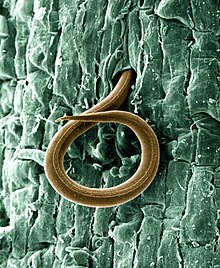
Back Cənub fır nematodu Azerbaijani Meloidogyne incognita Esperanto Meloidogyne incognita Spanish Meloidogyne incognita French Meloidogyne incognita Icelandic Meloidogyne incognita Dutch Meloidogyne incognita Russian Галова нематода південна Ukrainian 根结线虫 Chinese
| Meloidogyne incognita | |
|---|---|

| |
| Scientific classification | |
| Domain: | Eukaryota |
| Kingdom: | Animalia |
| Phylum: | Nematoda |
| Class: | Secernentea |
| Order: | Tylenchida |
| Family: | Heteroderidae |
| Genus: | Meloidogyne |
| Species: | M. incognita
|
| Binomial name | |
| Meloidogyne incognita (Kofoid & White, 1919)
| |
Meloidogyne incognita (root-knot nematode, RKN), also known as the southern root-nematode or cotton root-knot nematode is a plant-parasitic roundworm in the family Heteroderidae. This nematode is one of the four most common species worldwide and has numerous hosts. It typically incites large, usually irregular galls on roots as a result of parasitism.
M. incognita can move along shallower temperature gradients (0.001 °C/cm) than any other known organism,[1] an example of thermotaxis. The response is complicated and thought to allow the nematodes to move toward an appropriate level in soil,[2] while they search for chemical cues that can guide them to specific roots.[3][4][5]
- ^ Pline, Diez, and Dusenbery, J. Nematology, 20:605-608 (1988). Extremely sensitive thermotaxis of the nematode Meloidogyne incognita.
- ^ Dusenbery, D.B. Biological Cybernetics, 60:431-437 (1989). A simple animal can use a complex stimulus pattern to find a location.
- ^ Pline and Dusenbery. 1987. Responses of the plant-parasitic nematode Meloidogyne incognita to carbon dioxide determined by video camera-computer tracking. Journal of Chemical Ecology. 13 : 873-888.
- ^ Dusenbery. 1987. The theoretical range over which bacteria and nematodes locate plant roots using carbon dioxide. Journal of Chemical Ecology. 13 : 1617-1624.
- ^ Diez and Dusenbery. 1989. Repellent of root-knot nematodes from the exudate of host roots. Journal of Chemical Ecology. 15:2445-2455.